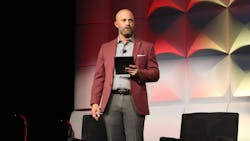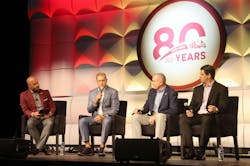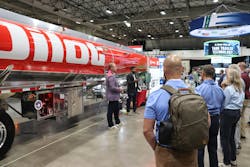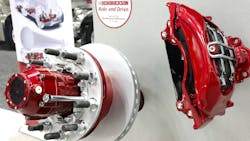Bridging the Gap: Bulk haulers, suppliers seek alignment on safety, tech, and regulations
Key Highlights
- Industry leaders emphasized the importance of collaboration between OEMs, fleets, and associations to align goals and improve data sharing for better regulatory compliance.
- Smart trailer technologies, including integrated safety systems and dynamic tire pressure management, are enhancing safety and operational efficiency.
- Predictive maintenance powered by AI and telematics is seen as the future driver for reducing downtime and lowering total cost of ownership.
- Manufacturers are focusing on balancing lightweight design with safety, ensuring durability through rigorous testing and quality components.
- Supply chain resilience is being strengthened by diversifying suppliers and adopting flexible manufacturing strategies to mitigate disruptions.
Tank truckers are looking for answers in an era of uncertainty. The industry’s trade association is doing its best to find them.
David Price, National Tank Truck Carriers chairman and United Petroleum Transports executive vice chairman, sat down with truck, trailer, and component suppliers during Tank Truck Week 2025 in Kansas City, Missouri, to examine how equipment manufacturers, fleets, and industry associations can better align their goals while meeting the ever-increasing demands of regulators. Key topics they discussed included vehicle data sharing, deploying smart trailer technologies, and improving lines of communication across the supply chain.
The panel, which included Kenworth Central Sales Manager Brian Pasko, EnTrans International President and COO Jake Radish, and Hendrickson Vice President of Global Sales Rence Oliphant, highlighted the importance of predictive maintenance using artificial intelligence and telematics to improve efficiency and reduce downtime. They also discussed the myriad challenges, like stringent emissions requirements, supply chain disruptions, and the impact of tariffs, along with the need for flexible manufacturing and resilient sourcing strategies.
Questions and answers are edited for length and clarity.
Price: We often see different parts of the supply chain pulling in opposite directions. How can OEMs, fleets, and associations better align their goals?
Radish: The first part to understand is the planning windows associated with OEMs, fleets, and regulators. They’re on different horizons. OEMs are focused on capacity and design progress. Fleets’ priorities are operational efficiencies, utilization, and trade cycles; and regulators are working on policy objectives, which typically are aligned with political cycles. If you unpack all that, the most important thing is for us to work together to collect the data up front, and that entails fleets and OEMs working together to gather performance information from the real operational characteristics of how fleets work every day. When you put that in front of a regulator sooner than later, it fills in what would be white space without data.
Oliphant: Hendrickson and Kenworth are both proud members of Act 1, the Allied Committee for the Trucking Industry, and we work hand in hand with associations and customers to make sure our voice is heard. The 26 companies that make up Act 1 are OEMs and suppliers that support the entire industry. We were recently on Capitol Hill. We met with [NTTC President and CEO] Ryan [Streblow] and the NTTC crew, and ATA [American Trucking associations] and TCA [Truckload Carriers Association], because we wanted to hear what their priorities were, and we went up on the Hill with TCA and started voicing how we’d like to see FET repealed. We also need more truck parking. So, the key here is communication. We need to keep working together and make sure we have our priorities aligned.
Pasko: From our standpoint, open, transparent communication up and down the supply chain is critical. If we’re not giving our suppliers accurate visibility into our forecasting, it slows everything down, and that goes hand in hand with trailer manufacturers, body builders, and so on. So, it’s all about open communication, and establishing the foundation of alignment, whether that be increasing safety, emissions requirements, or something else.
Price: What are OEMs doing to better integrate safety technologies into tank trailers?
Radish: There are a couple examples here today. Trailers have now moved into not just a bolt-on option of, hey, we have GPS, or we have cameras. It’s a fully integrated intelligent system. We’ve moved from the ‘DeLorean’ era, let’s say, to the modern-day transformation of vehicle intelligence. For example, we’re monitoring roll stability, and we’re able to dynamically influence the trailer itself. You’ve also got protection when you’re backing up a trailer. Certainly, the cameras are a key safety feature. All of these components integrated together bring the fleet more data to change how they’re operating their business; and when that happens, you can increase the safety associated with your organization and your company.
Price: Are there any features that have been adopted at a higher rate than others you’re offering?
Radish: One of the most adopted options would be tire inflation and deflation, what we call dynamic tire pressure, where the fleet is able to manage the inputs on the upper and lower control limits based on load characteristics. So, when you’re loading or unloading your trailer, you have upper and lower thresholds set for tire pressures, and you’re making sure tires are not underinflated, which is the highest blowout risk.
See also: Drōv, Kraft deliver smart solutions to aftermarket
Price: How do you balance the push for lightweight equipment with maintaining structural integrity and safety management?
Oliphant: The products we manufacture are safety critical components. We can’t afford for an axle, suspension, or braking system to fail, so we go through a rigorous development process to make sure those products are safe. It starts with a request from a fleet or OEM that wants something specific. We’ll take it back and kick it around with product planning, engineering, and marketing to make sure it’s something that makes sense for us. At that point, we’ll start developing concepts. We’ll do destructive testing in our labs, and from there, if it looks like this has promise, we’ll take evaluation units out to the test track and then the field, and we’ll make sure our service team goes out there and looks at it. But the big thing is, we want reliable products. It’s great if we can take some weight out, but it must be durable and safe.
Price: If you could change one regulatory requirement to better balance safety, efficiency, and innovation, what would it be?
Pasko: From an OEM’s perspective, we’re always torn between developing products that balance emissions, safety, and fuel economy, while also maintaining innovation and being able to attract drivers and ultimately make carriers money. So, it’s probably never going to happen, but from a regulatory standpoint, it would be the emissions requirements staring us all in the face. We could advocate for more flexible regulatory requirements, as a performance-based solution, instead of prescriptive mandates. That would be great, but I don’t see it happening. So, realistically, the biggest thing we can do is integrate more ADAS features that keep everybody on the road safer. From a safety perspective, there are opportunities to enact safety mandates that make everybody—especially in the litigious society we live in—safer on the road.
Price: What feedback from fleets has been the biggest influence on product design or innovation in recent years?
Radish: In general, it’s lifecycle economics. The expectations associated with a tank trailer for lasting longer, having better corrosion protection, and better resale value are the top-line indicator for us. And so, we’re working on things like FEA [finite element analysis] modeling within our engineering teams to make sure we’re accomplishing that. And really, with the linkage between an OEM and fleet, the most important perspective is getting out in the field with them, because you can’t replicate the same dynamics in a lab as you see in the real world.
Oliphant: For us, it’s a lot of integration. We’ve gotten those requests to see components under one manufacturer. We realize that means one person or company to point a finger at, so we’ll take that on. But part of that also is the expectation that all these components will work together to give you the efficiency, and lifecycle durability, you’re looking for.
Pasko: We’re in the same boat. We’ve gotten a lot of impactful feedback based on the need for greater reliability, ease of maintenance, and dealership throughput. It’s all about maximizing the uptime of trucks on the road. Spares are in short supply right now. It’s not like it was 5-10 years ago, so we’re working hand in hand, and all OEMs have strategic initiatives around increasing technician capacity and bay counts at our dealerships to give customers a better experience and get them in and out of the shop faster.
See also: Phillips Connect integrates Hendrickson insights
Price: Is there anything out there that is the one big innovation you see on the horizon for the equipment we use every day?
Radish: Having the data associated with predictive maintenance is going to be the No. 1 driver for fleets. I have a vision, in the next 5-10 years, where a fleet operator can find a problem, identify it directly within their flow path, and get a call saying, ‘Hey, bring your tractor or trailer into this location because we have the parts on hand to get it fixed.’ That will increase the efficiency and optimization of that fleet … and drive down total cost of ownership.
Oliphant: I second that. Telematics communication is going to be huge as we go forward, and on our part it’s sensors. We’re going to need those sensors on the brakes, and the wheel ends, to supply that data for predictive analytics. And ideally, what we’d like to get to, is when you know you’ve got a seven-year wheel end, and it’s coming to the end of its warranty period, you have it serviced. If you get a notice saying, ‘Hey, it’s time to do it, and that part is sitting on the shelf at either this dealership or that location,’ and you can then schedule that in advance, and have the bay open and the parts there, you can get it in and out faster.
Pasko: We’re in the same boat. Anything we can do predictive maintenance-wise, whenever you can take an unplanned issue or downtime and turn it into a planned service event based on prognostics or information derived from AI, that’s going to save a lot of money and time—and heartburn for drivers as well. So predictive maintenance is high on every OEM’s list right now, and we’re just scratching the surface with AI. As it evolves, it’ll be more beneficial to everyone.
Price: What specific design improvements are helping lower our maintenance costs and extend the lifecycle of our equipment?
Oliphant: Wheel ends are a big part of it now. Anytime a technician goes into a wheel end, there’s a greater chance of having a problem down the road. That’s why we put a lot of focus into assembling wheel ends with components we test. Five- and seven-year warranties on wheel ends are common now because of the way we assemble them. We really don’t have any downtime. We don’t have maintenance problems. It’s a once-a-year check. You rotate it, and if you don’t see any lube coming out, and you don’t hear anything unusual, you put it right back on the road.
Price: In terms of total cost of ownership for our assets, where do you see the greatest opportunities for fleets to save over the next 8-10 years?
Radish: If you look at the modernization of the technology out there today, fleets can now truly understand their total cost of ownership. And bringing it to a maintenance shop, specs are going to be very important in harmonizing your fleet and ensuring you’re stocking the right components. That’s going to be a primary driver you’ll see. Also, when you take it on the road, and an operator is able to bring a tractor or trailer in with the utilization factors you’re likely not seeing today—but will see with the various technologies out there, from a data collection standpoint—it’s important for fleets to react to that information, make it a preventative change to their maintenance programs and get in front of the various facets that may shut them down.
See also: Pilot surprises Road Warrior with Kenworth truck
Price: From a supply chain standpoint, what lessons from previous disruptions we’ve experienced are shaping long-term sourcing and production strategies?
Pasko: The supply chain continues to be disrupted since Covid, and that has underscored the importance of resiliency and developing flexible manufacturing and sourcing. OEMs have learned to diversify their supplier bases to avoid overreliance on either a single region—which is what we’re dealing with right now, with the political environment—or certain suppliers. Many of the Tier 2 and 3 suppliers are utilized by the same manufacturers, which creates a challenge downstream, and a downward market with capacity issues, but … it’s just prioritizing what you can, given the tools you have, and you must stay on your toes to try and find new suppliers, especially at that Tier 2 and 3 levels. Your primary OEM suppliers are great. They support every facet of the market. But with Tiers 2 and 3, you get into, is it more beneficial to have safety stock or do just in time? And you move away from some of the customization, so you’re looking at more of a cookie-cutter spec. So, there are many challenges, and they continue to evolve.
Oliphant: No doubt about it. I used to wonder what our purchasing team did. I thought they had a cakewalk job, but the last few years they’ve worked harder than anybody, trying to source certain components, from China to Mexico to the U.S., to get around tariffs. They’re working hard, and it’s all on your behalf. We’re trying to keep our costs down.
Price: What’s your biggest challenge for serving our industry in the next three to five years?
Pasko: Our biggest challenge as an OEM is navigating the increasingly stringent emissions requirements, and having the ability to deliver reliable, cost-effective trucks that meet the operational needs of our carriers. That’s No. 1. And then also the integration of the advanced emissions-regulation systems, and zero-emission vehicles, and balancing that with payload capacity.
Oliphant: Our challenge is finding steel and rubber that are cost effective. We’re looking at different suppliers right now. So, it’s trying to find components at the right price. And then, we’re not a telematics company, and we don’t want to be a telematics company, but we are going to try and supply the sensors fleets need. But now there are so many different telematics companies to work with, so we’re trying to make sure we pick the ones that are going to stick around as we go forward. A lot of consolidation is happening in that space, as it is throughout the industry, and looking at the trucking industry as a whole, that’s one of my concerns with these downturns. When you talk about Tier 2 and 3 suppliers, there’s no doubt we’re going to lose some, whether it’s through consolidation or going out of business. We're in a downturn now, but we know the upcycle is coming, and we’re trying to put the investments in place to make sure we can support our customers when it comes.
Radish: From a manufacturing standpoint, it’s about ensuring we’re threading the needle and prioritizing between modernization and reality. From the standpoint of telematics, we’ve done a lot of dirty work over the last five years, really testing that with fleets, so we know what works, and we’ve picked the right supply base to bring everything into one intelligent platform. That’s what is going to drive more value. We can’t get out over our skis and grab every option possible.
Bulk Transporter: How have tariffs affected your operations, and how are you adjusting to avoid passing on additional costs to customers?
Pasko: Nobody knows what the next executive order is going to bring, so it’s hard to plan. There’s a lot of contingency planning around what might or might not happen. But from an OEM standpoint, we’ve adjusted and tried to develop more flexible manufacturing and build trucks in areas where we don’t have the import or export tariffs related to Section 232. For example, with our medium-duty trucks built in Canada for the U.S. market, we’ve already shifted some of that production to the U.S., and we’ve shifted some heavy-duty trucks up to our Canadian plant to support the Canadian market. So, it’s flexible manufacturing, and then just waiting to see if the 232 tariffs stay in place or not. But it’s been a challenge with all the other USMCA [United States-Mexico-Canada Agreement] and IEEPA [International Emergency Economic Powers Act] tariffs—all those stacking tariffs—so materials purchasing and government affairs are extremely busy.
Oliphant: We’re very fortunate to be a U.S. manufacturer. Most of our plants are throughout the Southeast, in Tennessee, Kentucky, Ohio, and Indiana. That is where much of our production is located. We do have a plant Canada, and one in Mexico, and we are looking at, what can we do to further minimize the impact to us and our OEM friends, as well as end users?
About the Author
Jason McDaniel
Jason McDaniel, based in the Houston TX area, has more than 20 years of experience as an award-winning journalist. He spent 15 writing and editing for daily newspapers, including the Houston Chronicle, and began covering the commercial vehicle industry in 2018. He was named editor of Bulk Transporter and Refrigerated Transporter magazines in July 2020.





